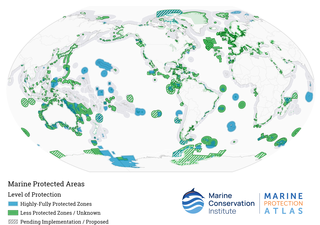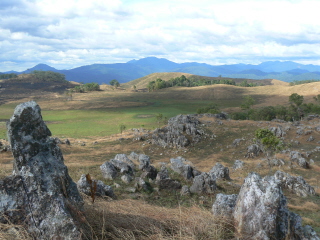Related Research Articles

The Convention on Biological Diversity (CBD), known informally as the Biodiversity Convention, is a multilateral treaty. The Convention has three main goals: the conservation of biological diversity ; the sustainable use of its components; and the fair and equitable sharing of benefits arising from genetic resources. Its objective is to develop national strategies for the conservation and sustainable use of biological diversity, and it is often seen as the key document regarding sustainable development.

The United Nations Environment Programme (UNEP) is responsible for coordinating responses to environmental issues within the United Nations system. It was established by Maurice Strong, its first director, after the United Nations Conference on the Human Environment in Stockholm in June 1972. Its mandate is to provide leadership, deliver science and develop solutions on a wide range of issues, including climate change, the management of marine and terrestrial ecosystems, and green economic development. The organization also develops international environmental agreements; publishes and promotes environmental science and helps national governments achieve environmental targets.

Protected areas or conservation areas are locations which receive protection because of their recognized natural, ecological or cultural values. Protected areas are those areas in which human presence or the exploitation of natural resources is limited.

The International Union for Conservation of Nature (IUCN) is an international organization working in the field of nature conservation and sustainable use of natural resources. Founded in 1948, IUCN has become the global authority on the status of the natural world and the measures needed to safeguard it. It is involved in data gathering and analysis, research, field projects, advocacy, and education. IUCN's mission is to "influence, encourage and assist societies throughout the world to conserve nature and to ensure that any use of natural resources is equitable and ecologically sustainable".
This is an index of conservation topics. It is an alphabetical index of articles relating to conservation biology and conservation of the natural environment.

Marine protected areas (MPA) are protected areas of the world's seas, oceans, estuaries or in the US, the Great Lakes. These marine areas can come in many forms ranging from wildlife refuges to research facilities. MPAs restrict human activity for a conservation purpose, typically to protect natural or cultural resources. Such marine resources are protected by local, state, territorial, native, regional, national, or international authorities and differ substantially among and between nations. This variation includes different limitations on development, fishing practices, fishing seasons and catch limits, moorings and bans on removing or disrupting marine life. In some situations, MPAs also provide revenue for countries, potentially equal to the income that they would have if they were to grant companies permissions to fish. The value of MPA to mobile species is unknown.

Virachey National Park is a national park in north-eastern Cambodia covering an area of 3,380.57 km2 (1,305.25 sq mi).

The Central Asian Flyway (CAF), Central Asian-Indian Flyway, or Central Asian-South Asian Flyway is a flyway covering a large continental area of Eurasia between the Arctic Ocean and the Indian Ocean and the associated island chains. The CAF comprises several important migration routes of waterbirds, most of which extend from the northernmost breeding grounds in Siberia to the southernmost non-breeding wintering grounds in West Asia, India, the Maldives and the British Indian Ocean Territory.

Abashiri Quasi-National Park is a quasi-national park in Japan. The park protects the waters and surrounding coastline of the lakes and lagoons along the Sea of Okhotsk on Hokkaidō. This includes such lakes as Lake Abashiri and Lake Notoro as well as Lake Tōfutsu and Lake Saroma. Lake Saroma is the fourth largest lake in Japan. Most of the park lies within the limits of Abashiri in Abashiri Subprefecture of northeastern Hokkaidō.
Niseko-Shakotan-Otaru Kaigan Quasi-National Park is a quasi-national park in the Shiribeshi Subprefecture of Hokkaido, Japan. On the coast of the Sea of Japan, there is a Marine Protected Area covering the west and north coast of Shakotan peninsula from Kamoenai to Otaru. The park also protects the area around the Mount Raiden and Niseko Volcanic Groups. Niseko-Shakotan-Otaru Kaigan Quasi-National Park was established in 1963.

The World Database on Protected Areas (WDPA) is the largest assembly of data on the world's terrestrial and marine protected areas, containing more than 260,000 protected areas as of August 2020, with records covering 245 countries and territories throughout the world. The WDPA is a joint venture between the United Nations Environment Programme World Conservation Monitoring Centre and the International Union for Conservation of Nature World Commission on Protected Areas.
Indigenous and community conserved areas (ICCAs), or Indigenous peoples’ and community conserved territories and areas, are spaces de facto governed by Indigenous peoples or local communities with evidently positive outcomes for the conservation of biological and cultural diversity. In ICCAs, the continuation, revival, or modification of traditional practices and/or new initiatives succeed in protecting and restoring natural resources and cultural values in the face of new threats or opportunities. Some ICCAs are situated in remote ecosystems that have had minimum human influence, while others encompass areas of various regulations and magnitudes within regions strongly affected or modified by human occupation. ICCAs may or may not fit the IUCN definition of “protected area” but, when they do, they can fall into any IUCN protected area categories.

IUCN protected area categories, or IUCN protected area management categories, are categories used to classify protected areas in a system developed by the International Union for Conservation of Nature (IUCN).
The Common Database on Designated Areas or CDDA is a data bank for officially designated protected areas such as nature reserves, protected landscapes, national parks etc. in Europe.

An Area of Special Conservation Interest (ASCI) is a protected area in Europe or North Africa, part of the Emerald network established by the countries who have signed the Berne Convention on the Conservation of European Wildlife and Natural Habitats. The purpose of the ASCIs is to conserve and protect habitats and species defined in the convention.

Elizabeth Maruma Mrema is a Tanzanian biodiversity leader and lawyer, living in Montreal, Canada, who has been serving as Deputy Executive Director of the United Nations Environment Programme (UNEP) since 2023, under the leadership of Executive Director Inger Andersen.
Other effective area-based conservation measures (OECMs) are sites outside of protected areas that are governed and managed in ways that deliver the long-term in situ conservation of biodiversity. As of March 2023, 829 such sites have been reported to the World Database on Other Effective Area-based Conservation Measures, managed by the UN Environment Programme World Conservation Monitoring Centre. OECMs cover 3,094,741 km2 (1,194,886 sq mi) of the Earth's surface, accounting for 2,716,531 km2 (1,048,858 sq mi) on land and 378,209 km2 (146,027 sq mi) in the ocean.

The Kunming-Montreal Global Biodiversity Framework (GBF) is an outcome of the 2022 United Nations Biodiversity Conference. Its tentative title had been the "Post-2020 Global Biodiversity Framework". The GBF was adopted by the 15th Conference of Parties (COP15) to the Convention on Biological Diversity (CBD) on 19 December 2022. It has been promoted as a "Paris Agreement for Nature". It is one of a handful of agreements under the auspices of the CBD, and it is the most significant to date. It has been hailed as a "huge, historic moment" and a "major win for our planet and for all of humanity."
References
- ↑ UNEP (2004) UNEP Programmes and Resources for Environmental Education and Training. UNEP, Nairobi, Kenya & Earthprint, UK.
- ↑ UNEP-WCMC (2018) Annual Review 2017-18. UNEP-WCMC, Cambridge, UK.
- ↑ "UPEP WCMC Resources and data page" . Retrieved 2024-02-19.
- ↑ "Ocean Data Viewer" . Retrieved 2024-02-19.
- ↑ "WDPA Overview" . Retrieved 2024-02-19.
- ↑ "Protectedplanet.net home page" . Retrieved 2024-02-19.